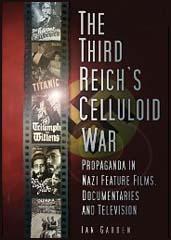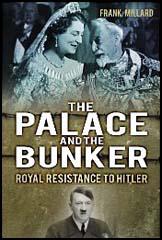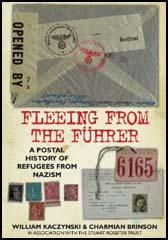Spartacus Review
Volume 57: 26th February, 2012
Nazi Germany

Title: The Third Reich's Celluloid War
Author: Ian Garden
Publisher: History Press
Price: £20.00
Bookshop: Amazon
Spartacus Website: Nazi Germany
Category: Nazi Germany
This book exposes the myths surrounding the propaganda films produced during the Third Reich. One, that the Nazis were infallible masters in the use of film propaganda. Two, that everything the Nazis said was a lie. Three, that only the Riefenstahl documentaries are significant to the modern viewer. It reveals the truth, lies, successes and failures of key films designed to arouse hostility against the Nazis' enemies, including Ohm Kruger - the most anti-British film ever produced; their 1943 anti-capitalist version of Titanic; anti-English films about Ireland and Scotland; and anti-American films like The Emperor of California and The Prodigal Son. Including an objective analysis of all the key films produced by the Nazi regime and a wealth of film stills, Ian C. Garden takes the reader on a journey through the Nazi propaganda machine. In today's turbulent world the book serves as a poignant reminder of the levels to which powerful regimes will stoop to achieve power and control.

Title: The Palace and the Bunker
Author: Frank Millard
Publisher: History Press
Price: £20.00
Bookshop: Amazon
Spartacus Website: Resistance in Nazi Germany
Category: Nazi Germany
A study of the role of German and Austrian royals in Hitler's defeat The part played by the many German and Austrian royal families in opposing Hitler has hitherto been overlooked, and this history outlines many incredible instances of their involvement. Prince Louis Ferdinand of Prussia was deeply involved in the German resistance movement and was questioned by the Gestapo following the July 20 plot on Hitler's life; Otto von Habsburg, heir to the Austro-Hungarian Empire, was sentenced to death and escaped through Europe to America, where he helped coordinate attempts to liberate his homeland; his Hohenberg cousins (children of the Archduke Franz Ferdinand) were incarcerated in Dachau; Crown Prince Rupprecht of Bavaria was exiled to Italy where he was pursued by the SS--his wife and children were captured and sent to concentration camps; and the exiled Prince Hubertus zu Lowenstein traveled between the U.S. and Britain assembling German exiles into groups representing the real Germany, so that they could assume power when Hitler was defeated. The sweeping away of German and Austrian monarchs in 1918 made the rise of Hitler possible; and their successors helped make possible his defeat.

Title: Fleeing from the Fuhrer
Author: William Kaczynski and Charmian Brinson
Publisher: History Press
Price: £20.00
Bookshop: Amazon
Spartacus Website: Nazi Germany Timeline
Category: Nazi Germany
The exodus of men, women and children fleeing from the Nazi regime was one of the largest diasporas the world has ever seen. It sparked an international refugee crisis that changed society and continues to shape our culture and community today. The years between 1933 and 1945, the Nazi era in Germany, and the war years, 1939 to 1945, were a time of destruction, upheaval and misery throughout Europe and beyond. Displacement and death, whether in war or civilian life, became everyday experiences, for young and old alike. Families were torn apart by enforced emigration or deportation. Parents were separated from their children, husbands from wives, brothers from sisters. Interned in camps that spread across the globe from Shanghai to the United States of America to the Isle of Man, they became strangers in a foreign land and often the only link they had to their former lives were letters exchanged with friends and family. These scarce postal communications, therefore, assumed huge significance in the lives of both sender and receiver, one that is hard to imagine today in the age of instant communication. Fleeing from the Fuhrer is an unusual collection of correspondence that shows the incredible nature of this worldwide emigration and the indomitable spirit of these refugees. Each postcard, envelope and item of ephemera tells its own unique story and is reproduced in full colour, making this a fascinating resource for anyone wanting to understand this poignant part of our international history.
.
